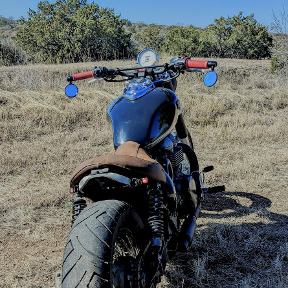Welcome to the Onshape forum! Ask questions and join in the discussions about everything Onshape.
First time visiting? Here are some places to start:- Looking for a certain topic? Check out the categories filter or use Search (upper right).
- Need support? Ask a question to our Community Support category.
- Please submit support tickets for bugs but you can request improvements in the Product Feedback category.
- Be respectful, on topic and if you see a problem, Flag it.
If you would like to contact our Community Manager personally, feel free to send a private message or an email.
Need Help Completing Loft - Surfboard Fin...
 larry_hawes
Member Posts: 478 PRO
larry_hawes
Member Posts: 478 PRO
I found a STEP file of a surfboard fin, imported in to OS and have a decent strategy to recreate it using the loft feature but can't quite find a way to complete the last part of the loft creating the end of the fin. I can see an additional 4 features in the STEP solid but was wondering if there was a way to recreate the end of the fin using a less complicated and more flexible method.
Thanks in advance
https://cad.onshape.com/documents/1ae2fdd02fb6c30fbd6639d5/w/cc3c6e812bfc0585f7d49753/e/6b3e0319577f61bb3f00eefe
Thanks in advance
https://cad.onshape.com/documents/1ae2fdd02fb6c30fbd6639d5/w/cc3c6e812bfc0585f7d49753/e/6b3e0319577f61bb3f00eefe
0
Best Answers
-
 owen_sparks
Member, Developers Posts: 2,660 PRO
I'd consider just lofting from a vertex to the end profile.
owen_sparks
Member, Developers Posts: 2,660 PRO
I'd consider just lofting from a vertex to the end profile.
Owen S.
Business Systems and Configuration Controller
HWM-Water Ltd5 -
 NeilCooke
Moderator, Onshape Employees Posts: 5,922
NeilCooke
Moderator, Onshape Employees Posts: 5,922  Hi @larry_hawes - when sharing a public doc, don't use the "link" option in the share dialog - that creates a view-only non-copyable doc - just make it public then share the URL from the browser bar.
Hi @larry_hawes - when sharing a public doc, don't use the "link" option in the share dialog - that creates a view-only non-copyable doc - just make it public then share the URL from the browser bar.
Anyway, loft to point like Owen says or try fill surface with guide curves/vertices.
Senior Director, Technical Services, EMEA5 -
 billy2
Member, OS Professional, Mentor, Developers, User Group Leader Posts: 2,115 PRO
Vertex matching is a pro/e thing, you can turn it off here. The vertex/point is the way to go but the point needs to be defined properly. Define a plane or face that's parallel to the fin's end:
billy2
Member, OS Professional, Mentor, Developers, User Group Leader Posts: 2,115 PRO
Vertex matching is a pro/e thing, you can turn it off here. The vertex/point is the way to go but the point needs to be defined properly. Define a plane or face that's parallel to the fin's end:
Here I'll do it in a different model:
Changing the attitude of the point's plane, It'll effect the curvature at the crown:
To illustrate this technique further, I changed the end condition of the point sketch from normal to tangent:
In summary, when you have a point on a plane using a sketch, Onshape knows about the point because you select it as a profile. What you need to understand is that Onshape also knows about the plane the point was drawn on and also uses this in your surface definition (normal / tangent).
5 -
 larry_hawes
Member Posts: 478 PRO
Thank you Billy that gives me a pretty intensive homework assignment. Curious about your first sentence, "Vertex matching is a pro/e thing, you can turn it off here." Not sure what pro/e is nor did I see where one might turn it off. Thank you again very much for taking the time to reply.0
larry_hawes
Member Posts: 478 PRO
Thank you Billy that gives me a pretty intensive homework assignment. Curious about your first sentence, "Vertex matching is a pro/e thing, you can turn it off here." Not sure what pro/e is nor did I see where one might turn it off. Thank you again very much for taking the time to reply.0 -
 billy2
Member, OS Professional, Mentor, Developers, User Group Leader Posts: 2,115 PRO
I commute north on the 101 and then cut over on oceanside blvd. through Vista.
billy2
Member, OS Professional, Mentor, Developers, User Group Leader Posts: 2,115 PRO
I commute north on the 101 and then cut over on oceanside blvd. through Vista.
I've worked with many surf shops with routers to make surf boards and fins. If you need some help, let me know.
5
Answers
Owen S.
HWM-Water Ltd
Anyway, loft to point like Owen says or try fill surface with guide curves/vertices.
Can't find a difference in the links whether copying from the dbx or the URL - the links look the same.
Here I'll do it in a different model:
Changing the attitude of the point's plane, It'll effect the curvature at the crown:
To illustrate this technique further, I changed the end condition of the point sketch from normal to tangent:
In summary, when you have a point on a plane using a sketch, Onshape knows about the point because you select it as a profile. What you need to understand is that Onshape also knows about the plane the point was drawn on and also uses this in your surface definition (normal / tangent).
As a surface is created, keeping it flowing properly and preventing it from bunching up is important and sometimes matching the vertices helps. In your case, your surfaces flow nicely and shouldn't need vertex mapping.
Another thing, as possibly a tip, your primary surfaces that you have defined, can be trimmed back. Then, you can add transition surfaces to connect everything together. This is a standard manifold technique used a lot, at least by me.
So trim your fin back a little bit:
And then add a transition surface between your primary surfaces:
So why would you want this? Because your primary surfaces flow nicely without much curvature. Then, upon transitioning to the other side, you might want tighter curvature. It's hard to control a free flowing surface with tight curvature at it's ends. This is why we have patches and break the manifold into surface patches. Each patch has it's own control.
Unless you want the razor's edge to slice through the water.
This is the bases of surface modeling. Think about the primary surfaces and then the transition surfaces that'll tie it all into a manifold.
You in San Diego?
Yeah I live in North County, Vista to be exact. You?
I've worked with many surf shops with routers to make surf boards and fins. If you need some help, let me know.